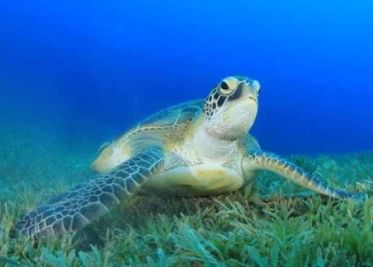![“Of the nesting sites with long-term data sets … the index beaches in Florida exhibit a strong positive trend in the PVAs [population viability analysis].” (Via Pinterest; cover: U of Florida) greenturtles1.jpg](/files/cache/782aaf184529bdebaebff01c2d5e32cf_f1097.jpg)
“Of the nesting sites with long-term data sets … the index beaches in Florida exhibit a strong positive trend in the PVAs [population viability analysis].” (Via Pinterest; cover: U of Florida)
The green sea turtle, whose populations in Florida are the second largest in the Western Hemisphere, is up for a demotion of sorts after 37 years on the endangered list. A federal proposal to downlist the sea turtle to a threatened species also calls for a new system of protection.
“The proposal … shows that conservation is making a difference,” Dan Ashe, director of the U.S. Fish and Wildlife Service, said in a statement.
 Green turtles nest in virtually every coastal county in Florida but are concentrated along Southeast shores, according to the state Fish and Wildlife Conservation Commission. Nesting totals fluctuate annually because Florida’s green turtles follow mostly a two-year migration pattern.
Green turtles nest in virtually every coastal county in Florida but are concentrated along Southeast shores, according to the state Fish and Wildlife Conservation Commission. Nesting totals fluctuate annually because Florida’s green turtles follow mostly a two-year migration pattern.
Last year, 5,895 nests were recorded statewide by FWC trackers, including 2,196 in Brevard. Sarasota County beaches were tops in Southwest Florida with 35 nests. In 2013, more than 36,000 nests were documented in Florida.
“The dramatic improvement of green sea turtle populations in U.S. waters, at a time when sea turtle populations in other parts of the world continue to decline, shows the Endangered Species Act saves wildlife,” said Miyoko Sakashita of the Center for Biological Diversity.
The proposed rule calls for the FWS and National Oceanic and Atmospheric Administration to divide the world’s green turtles into 11 “Distinct Population Segments.” Florida’s green turtles were put in the North Atlantic DPS.
In the rule: “Of the nesting sites with long-term data sets … the index beaches in Florida exhibit a strong positive trend in the PVAs [population viability analysis].”
Separate groups will allow wildlife stewards to focus on specific threats for each population, the agencies said.
A 90-day public comment period will take place before the green turtle joins the loggerhead as threatened. Leatherback, hawksbill and Kemp’s ridley are on the endangered list.
The Kemp’s ridley is found mostly in the Gulf and is the world’s most fragile sea turtle. It was also the hardest hit turtle in the BP Deepwater Horizon oil spill, marine experts say.
Outside
Bitcoin mining emissions in China will hit 130 million tonnes by 2024 https://t.co/w6He7so8N2 pic.twitter.com/qYUDtBdeRK
— New Scientist (@newscientist) April 9, 2021
The Gunk Report
For the Blue-Green Algal Bloom Weekly Update from the Florida Department of Environmental Protection, tap here. For DEP's Algal Bloom Sampling Map, tap here.
What, me worry?
» "PLAYING WITH SHARKS," which recently premiered at the Sundance Film Festival, documents diving legend Valerie Taylor.